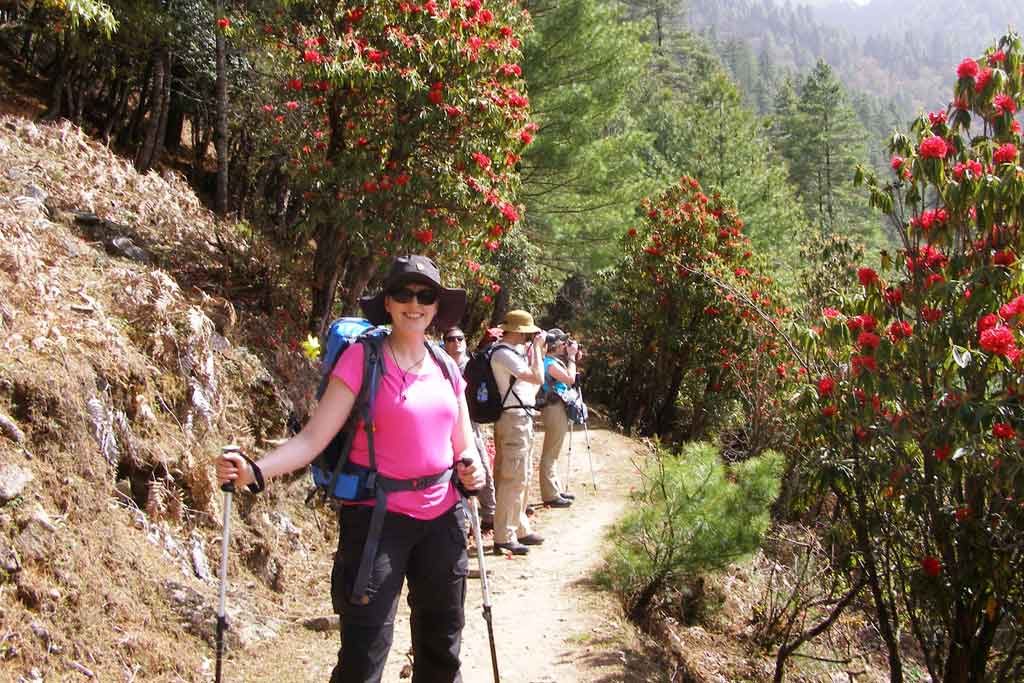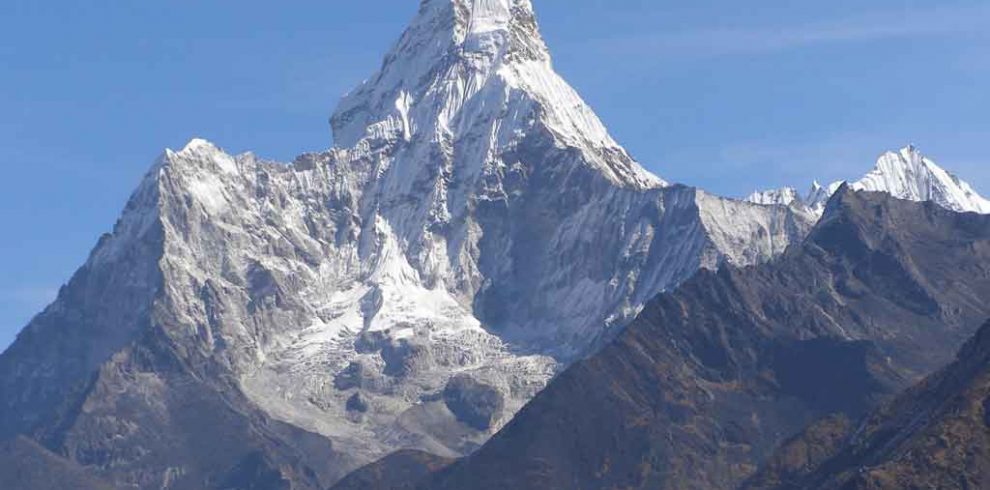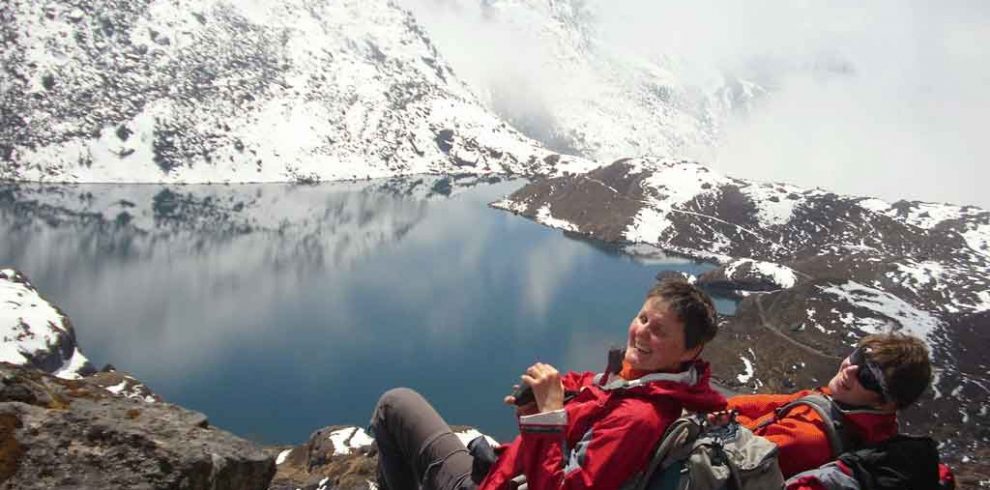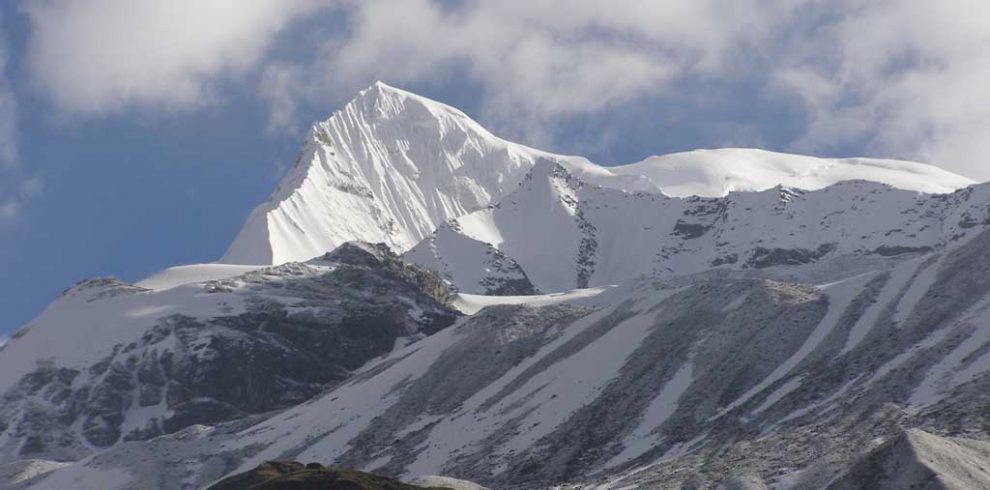Langtang-a narrow Valley rich in culture and cherished by nature lies towards the north of Kathmandu. The Langtang Valley trail follows through the ethnic Tamang settlements, lush green and rhododendron forest and the wide spread Kyanjin Valley known as Kyanjin Gompa. If you are travelling on a short holiday and want to do the Langtang trek, our Langtang Heli Trek – 3 Days can be the ideal itinerary.
This amazing land borders to Tibet but still far away from Tibetan Plateau. A trek to Langtang Valley combines the diversity of spectacular views of the Himalayas and exploration of traditional villages. Small peak climbing opportunities and visit to the glaciers at comfortably low elevations are extra attractions.
There are numerous highlights of Langtang Valley trekking. The main are rhododendron and bamboo forests with an abundance of wildlife and majestic waterfalls. Above all, magnificent views of the white giant Langtang Lirung (7,246m/23,774ft) and ascent to the Tserko Ri (5,033m/16,513ft) are more exciting.
Brief Itinerary:
| Day | Route | Altitude | Duration |
|---|---|---|---|
| 01 | Drive from Kathmandu to Dhunche | 2,030m/6,660ft | Drive: 8-9 hours |
| 02 | Trek Dhunche to Thulo Syabru Village | 2,210m/7,251ft | Trek: 5-6 hours |
| 03 | Trek Thulo Syabru Village to Lama Hotel | 2,410m/7,907ft | Trek: 5-6 hours |
| 04 | Trek Lama Hotel to Langtang Valley | 3,330m/10,925ft | Trek: 5-6 hours |
| 05 | Trek Langtang Valley to Kyanjing Gompa | 3,800m/12,467ft | Trek: 2-3 hours |
| 06 | Exploration day at Kyanjin Gompa/Climb Tserko Ri | 5,033m/16,513ft | Trek: 6-7 hours |
| 07 | Return trek Kyanjing Gompa to Lama Hotel | 2,410m/7,907ft | Trek: 6-7 hours |
| 08 | Trek Lama Hotel to Syabru Besi | 1,460m/4,790ft | Trek: 4-5 hours |
| 09 | Drive Syabru Besi to Kathmandu | 1,350m/4,430ft | Drive: 8-9 hours |
The summit of Tserko Ri offers the 360 degree views of Himalayan panorama. Kyanjing Gompa provides an opportunity to experience the spiritual lifestyle of dedicated Buddhist monks performing their rituals in a beautiful Monastery. Visit to the traditional cheese factory there and observation of the cheese manufacturing process by hand will also be interesting.
The entire Langtang region is protected within the boundaries of Langtang National Park and home to the shy Red Panda. If you are lucky, you might be able to spot them out. Due to the gradual ascents, Langtang Valley trek is not difficult but can demand some challenges also.
Why Langtang Valley Trek?
- Langtang consists of more than 70 glaciers of different sizes. Glaciers melted by the slopes of Dorje Lakpa, Langtang Lirung and other peaks feed the Langtang Khola (river). It is the same river to lead the main Langtang trekking trail.
- The Valley offers the panoramic vistas of Langtang and Ganesh Himal mountain ranges. Langtang is the nearest trekking region from the capital city Kathmandu where 7,000 meters peaks can be witnessed.
- Langtang National Park is bordered on the north by the Himalayas, dominated by Langtang Lirung (7,246m/23,774ft), being the highest peak in the area while to the south are the Chimse Danda (ridge), with the Ganja La pass (5,122m/16,805ft) and Jugal Himal, concluding in Dorje Lakpa (6,966m/22,855ft).
Meals and Accommodation in Langtang Region
Langtang Valley has a well set-up of comfortable teahouses and mountain lodges for trekkers. Rooms are available with triple/double beds. The standard is fairly good with warm blankets, fireplaces (in the dining), bathroom is mostly common and shared with the occasional hot shower (for an extra fee) and a variety of local and western food.
Trail Update: It was badly destroyed by the earthquake in 2015 and the Langtang village was completely swept away by the landslide. The trail is now back in operation in full swing. People have resumed their daily life with their usual smiling faces though they have a deep grief in their heart left by the massive earthquake.
Best Season for Langtang Valley Trek
Trekking in the Langtang National Park is possible all the year round in a few areas. However, the best seasons to trek in the Langtang Valley considered are the spring and autumn. The spring season starts from the early March until end of May and the autumn season begins from the early September to end of November.
The winters are very cold and monsoon makes poor visibility during summer. Although the days are sunny and warm, the temperatures at night can fall to freezing in higher elevations. So, it is important to have proper trekking equipment if you are trekking during winter. A good sleeping bag and a jacket are necessary for this trek. List of Equipment
Langtang Valley trek in late winter (Jan and Feb) can be more difficult if the trails are snow covered especially in Kyanjin Gompa and around. The teahouses may remain closed in Kyanjin if the weather is worst. The excursion trips are almost impossible at this time of year. April and early May bring the flowers into bloom and the entire hills turn into a marvelous garden.
Flora and Fauna in Langtang National Park
Langtang National Park is rich in terms of distribution of biodiversity. The southern section is covered by sub-tropical forest while the upper section has a dense forest of Chirpine, Rhododendron and Nepalese alder.
Between 2,600 to 3,600 meters, the Park is rich mainly with the deciduous conifer forest including silver fir, hemlock and larch. The Nepalese larch (Larixnepalensis) is the only deciduous conifer forest available in Langtang region.
The widespread alpine grassland meadows of Langtang Valley provide summer habitat for various ungulate species such as musk deer and Himalayan tahr. Langtang is famous to be the home of red panda, Himalayan black bear, snow leopard, wild dog, ghoral, serow and above 250 type of bird species.
Difficulty of Langtang Valley Trek
Langtang Valley trek is suitable for beginners. This trek is also doable with children. Its gradual ups are really helpful for your acclimatization. However, it is a good idea to train yourself with regular jogging for 4-5 hours everyday prior to the trek.
Langtang trekking around Kyanjin is a medium level trip but it will upgrade to medium-hard with the achievement of Tserko Ri summit at 5,033 meters. It is an optional day trip available from Kyanjing Gompa to the demanding trekkers.
So, the difficulty of this trek is fairly acceptable with average fitness. The ascends and descends through the narrow trails at some places require some patience. Once you arrive at Kyanjing Valley, it gives a feeling of worthy trip.
Trip Extensions
Trekking Encounters offers customized itinerary as per our trekkers’ holiday schedule and commits to deliver quality services as per their expectations. Please also visit the extended itinerary of Langtang Gosainkunda Trek – 14 Days including the Gosainkunda Lake.
Gosaikunda is a beautiful blue high-altitude lake with great religious value. It is preferable to trek through the Gosaikunda after Langtang Valley for better acclimatization. Having a good trekking map of Langtang region is a good idea and note down the altitude variations.
Alternatively, this trek combines well with the popular Tamang Heritage trail. Tamanag Heritage trail consists of the ethnic Tamang people, who are believed to be the offspring of people of Tibetan origin. This will require only 4 additional days.
Overview
- Free of complications of a flight
- Visit of Tibetan village in Langtang
- Trekking to the foot of the glaciers – Kyanjin Gompa
- Ascent of Tserko Ri (5,033m/16,513ft)
- Spectacular views of Langtang Ri and Ganesh Himal
- Mixed culture of Tamang and Lama societies
- The great countrysides and beautiful landscapes
- Impressive vegetation and flowers en-route










